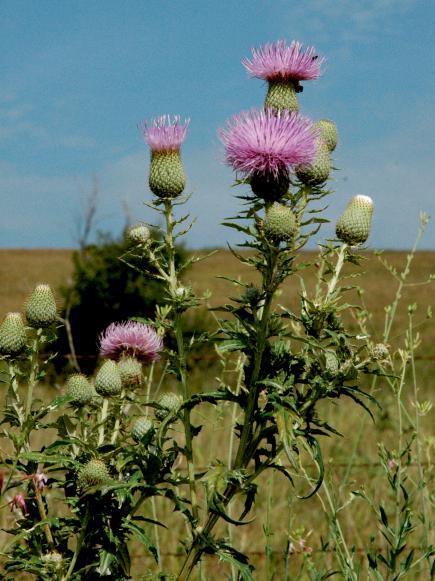Invasive Watch: Bull Thistle

Recognized as a noxious weed in many states, bull thistle is an invasive biennial that can wreak havoc along roadsides and other disturbed areas. Learn how to identify and control it effectively.
Recognized as a noxious weed in many states, bull thistle is an invasive biennial that can wreak havoc along roadsides and other disturbed areas. Learn how to identify and control it effectively.
Bull thistle (Cirsium vulgare) is a troublesome weed that is self-pollinated or insect-pollinated. It doesn’t take long for this dangerous plant to take over roadsides and inhibit roadway safety as well as environmental sustainability. Understanding the threats it poses and how to prevent it from invading roadside rights-of-way can make a world of difference for vegetation managers, drivers and wildlife alike.
Bull thistle tolerates a wide range of conditions, including sunny, open areas and various soil types. The plant’s bur-like seeds cling to animals, pant legs and machinery and remain viable in the ground for years. At full maturity, this tall-growing pest is capable of outcompeting desirable low-growing plants and grasses that support roadway safety and environmental sustainability.
For a wildflower, bull thistle is fairly large. Its erect structure can grow up to 6 feet tall and features a number of distinguishing features:
The long, robust leaves of bull thistle plants are covered densely with sharp spines and extend from spiny-winged stems. Each leaf is rough to the touch; the top surface is deeply lobed and hairy while the underside commonly features wool-like hairs.
Basal rosettes of bull thistle form in the first year of development and commonly grow up to 3 feet in diameter. A cluster of leaves extend from the taproot either on or near the soil surface. Each taproot can grow up to 28 inches tall.
During the second year of development, bull thistle will develop flowering stems that produce spine-covered fruit and bright-pink or white flowers atop the terminal root. Flowering in the second year most commonly starts in mid-June and continues into early fall.

As bull thistle only reproduces by seed, avoiding mowing practices and other activities that facilitate seed spreading is critical. Digging and other manual control methods can be used but they can be time-consuming and particularly costly. Comparatively, selective herbicide applications are a preferred alternative as they offer sustainable results for optimum efficacy.
Applying TerraVue® herbicide from Corteva Agriscience to rosettes or bolting plants at a rate of 2 to 2.85 ounces per acre in the spring and early summer is an effective approach to controlling bull thistle. TerraVue also can be applied at the same use rate to seedlings and rosettes in the fall or from late bolting through early flowering growth stages. When the plant has reached late bud stages, 1 pound of 2,4-D active ingredient per acre should be tank-mixed with TerraVue prior to application for optimum results.
For more information on invasive plants and vegetation control strategies or chemistries that can maintain effective control, explore our digital archive.
Under normal field conditions, TerraVue® is nonvolatile. TerraVue has no grazing or haying restrictions for any class of livestock, including lactating dairy cows, horses (including lactating mares) and meat animals prior to slaughter. Label precautions apply to forage treated with TerraVue and to manure and urine from animals that have consumed treated forage. TerraVue is not registered for sale or use in all states. Contact your state pesticide regulatory agency to determine if a product is registered for sale or use in your state. Consult the label for full details. Always read and follow label directions.
For over 30 years, Vistas® has covered strategies, trends and stories from across the Vegetation Management industry.